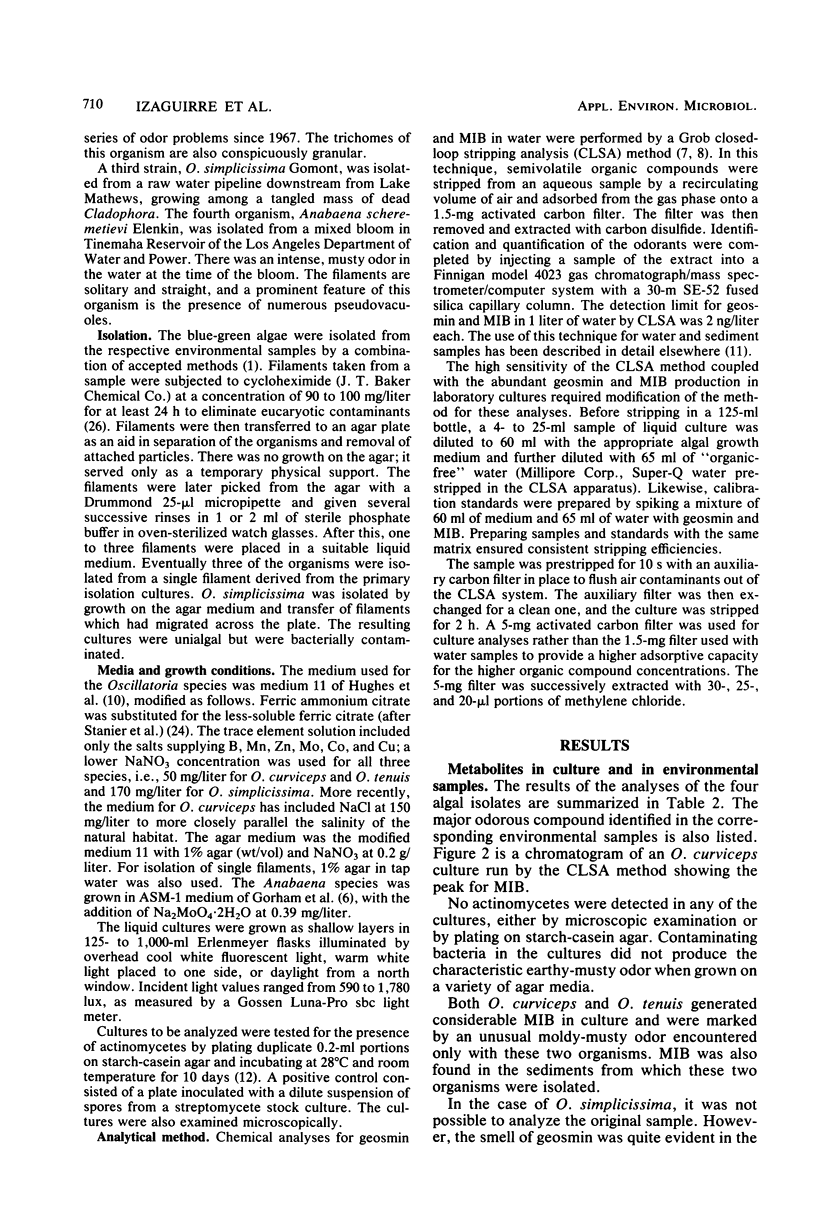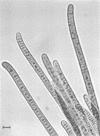Abstract
Three Oscillatoria strains and one Anabaena species were isolated from three different water supply systems in California that experienced earthy-musty taste and odor problems in their drinking water. Unialgal cultures, free of actinomycetes, were purged using the Grob closed-loop stripping analysis method, and the resulting methylene chloride extracts were analyzed on a gas chromatograph/mass spectrometer. Geosmin was produced by Oscillatoria simplicissima and Anabaena scheremetievi, and 2-methylisoborneol was produced by O. curviceps and O. tenuis. These compounds are the two major causes of earthy-musty tastes and odors in water. In three instances, the major odorant found in culture was previously identified in the water or sediment sample from which the respective organism was isolated. O. curviceps was implicated in a taste and odor episode involving 2-methylisoborneol in a major reservoir. Geosmin and 2-methylisoborneol were easily detected with culture samples of only 4 to 25 ml.
Full text
PDF






Images in this article
Selected References
These references are in PubMed. This may not be the complete list of references from this article.
- Cees B., Zoeteman J., Piet G. J. Cause and identification of taste and odour compounds in water. Sci Total Environ. 1974 Sep;3(1):103–115. doi: 10.1016/0048-9697(74)90042-4. [DOI] [PubMed] [Google Scholar]
- Gerber N. N., Lechevalier H. A. Geosmin, an earthly-smelling substance isolated from actinomycetes. Appl Microbiol. 1965 Nov;13(6):935–938. doi: 10.1128/am.13.6.935-938.1965. [DOI] [PMC free article] [PubMed] [Google Scholar]
- Giannovario J. A., Grob R. L., Rulon P. W. Analysis of trace pollutants in the air by means of cryogenic gas chromatography. J Chromatogr. 1976 Jun 23;121(2):285–294. doi: 10.1016/s0021-9673(00)85025-6. [DOI] [PubMed] [Google Scholar]
- Grob K. Organic substances in potable water and in its precursor. I. Methods for their determination by gas-liquid chromatography. J Chromatogr. 1973 Sep 26;84(2):255–273. doi: 10.1016/s0021-9673(01)91705-4. [DOI] [PubMed] [Google Scholar]
- HUGHES E. O., GORHAM P. R., ZEHNDER A. Toxicity of a unialgal culture of Microcystis aeruginosa. Can J Microbiol. 1958 Jun;4(3):225–236. doi: 10.1139/m58-024. [DOI] [PubMed] [Google Scholar]
- KUESTER E., WILLIAMS S. T. SELECTION OF MEDIA FOR ISOLATION OF STREPTOMYCETES. Nature. 1964 May 30;202:928–929. doi: 10.1038/202928a0. [DOI] [PubMed] [Google Scholar]
- Stanier R. Y., Kunisawa R., Mandel M., Cohen-Bazire G. Purification and properties of unicellular blue-green algae (order Chroococcales). Bacteriol Rev. 1971 Jun;35(2):171–205. doi: 10.1128/br.35.2.171-205.1971. [DOI] [PMC free article] [PubMed] [Google Scholar]
- ZEHNDER A., HUGHES E. O. The antialgal activity of acti-dione. Can J Microbiol. 1958 Aug;4(4):399–408. doi: 10.1139/m58-042. [DOI] [PubMed] [Google Scholar]



